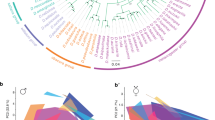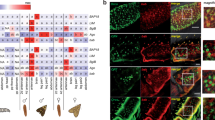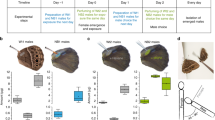Abstract
Sex pheromones play a pivotal role in the communication of many sexually reproducing organisms1. Accordingly, speciation is often accompanied by pheromone diversification enabling proper mate finding and recognition2. Current theory implies that chemical signals are under stabilizing selection by the receivers who thereby maintain the integrity of the signals3. How the tremendous diversity of sex pheromones seen today evolved is poorly understood4,5. Here we unravel the genetics of a newly evolved pheromone phenotype in wasps and present results from behavioural experiments indicating how the evolution of a new pheromone component occurred in an established sender–receiver system. We show that male Nasonia vitripennis evolved an additional pheromone compound differing only in its stereochemistry from a pre-existing one. Comparative behavioural studies show that conspecific females responded neutrally to the new pheromone phenotype when it evolved. Genetic mapping and gene knockdown show that a cluster of three closely linked genes accounts for the ability to produce this new pheromone phenotype. Our data suggest that new pheromone compounds can persist in a sender’s population, without being selected against by the receiver and without the receiver having a pre-existing preference for the new pheromone phenotype, by initially remaining unperceived. Our results thus contribute valuable new insights into the evolutionary mechanisms underlying the diversification of sex pheromones. Furthermore, they indicate that the genetic basis of new pheromone compounds can be simple, allowing them to persist long enough in a population for receivers to evolve chemosensory adaptations for their exploitation.
This is a preview of subscription content, access via your institution
Access options
Subscribe to this journal
Receive 51 print issues and online access
$199.00 per year
only $3.90 per issue
Buy this article
- Purchase on Springer Link
- Instant access to full article PDF
Prices may be subject to local taxes which are calculated during checkout



Similar content being viewed by others
References
Wyatt, T. D. Pheromones and Animal Behaviour Ch. 3 37–73 (Cambridge Univ. Press, 2003)
Smadja, C. & Butlin, R. K. On the scent of speciation: the chemosensory system and its role in premating isolation. Heredity 102, 77–97 (2009)
Butlin, R. K. & Trickett, A. J. in Insect Pheromone Research: New Directions (eds Cardé, R. T. & Minks, A. K. ) 548–562 (Chapman & Hall, 1997)
Symonds, M. R. E. & Elgar, M. A. The evolution of pheromone diversity. Trends Ecol. Evol. 23, 220–228 (2008)
Steiger, S., Schmitt, T. & Schaefer, H. M. The origin and dynamic evolution of chemical information transfer. Proc. R. Soc. B 278, 970–979 (2011)
Roelofs, W. L. & Rooney, A. P. Molecular genetics and evolution of pheromone biosynthesis in Lepidoptera. Proc. Natl Acad. Sci. USA 100, 9179–9184 (2003)
Ferveur, J.-F. Cuticular hydrocarbons: their evolution and roles in Drosophila pheromonal communication. Behav. Genet. 35, 279–295 (2005)
Xue, B., Rooney, A. P., Kajikawa, M., Okada, N. & Roelofs, W. L. Novel sex pheromone desaturases in the genomes of corn borers generated through gene duplication and retroposon fusion. Proc. Natl Acad. Sci. USA 104, 4467–4472 (2007)
Shirangi, T. R., Dufour, H. D., Williams, T. M. & Carroll, S. B. Rapid evolution of sex pheromone-producing enzyme expression in Drosophila . PLoS Biol. 7, e1000168 (2009)
Lassance, J.-M. et al. Allelic variation in a fatty-acyl reductase gene causes divergence in moth sex pheromones. Nature 466, 486–489 (2010)
Liénard, M. A., Hagström, A. K., Lassance, J.-M. & Löfstedt, C. Evolution of multicomponent pheromone signals in small ermine moths involves a single fatty-acyl reductase gene. Proc. Natl Acad. Sci. USA 107, 10955–10960 (2010)
Albre, J. et al. Sex pheromone evolution is associated with differential regulation of the same desaturase gene in two genera of leafroller moths. PLoS Genet. 8, e1002489 (2012)
Werren, J. H. & Loehlin, D. W. The parasitoid wasp Nasonia: an emerging model system with haploid male genetics. Cold Spring Harb. Protocols 2009, pdb.emo134 (2009)
Werren, J. H. et al. Functional and evolutionary insights from the genomes of three parasitoid Nasonia species. Science 327, 343–348 (2010)
Ruther, J., Stahl, L. M., Steiner, S., Garbe, L. A. & Tolasch, T. A male sex pheromone in a parasitic wasp and control of the behavioral response by the female’s mating status. J. Exp. Biol. 210, 2163–2169 (2007)
Ruther, J., Steiner, S. & Garbe, L.-A. 4-Methylquinazoline is a minor component of the male sex pheromone in Nasonia vitripennis . J. Chem. Ecol. 34, 99–102 (2008)
Abdel-latief, M., Garbe, L. A., Koch, M. & Ruther, J. An epoxide hydrolase involved in the biosynthes is of an insect sex attractant and its use to localize the production site. Proc. Natl Acad. Sci. USA 105, 8914–8919 (2008)
Steiner, S. & Ruther, J. Mechanism and behavioral context of male sex pheromone release in Nasonia vitripennis . J. Chem. Ecol. 35, 416–421 (2009)
Munoz-Torres, M. C. et al. Hymenoptera Genome Database: integrated community resources for insect species of the order Hymenoptera. Nucleic Acids Res. 39, D658–D662 (2011)
Niehuis, O. et al. Recombination and its impact on the genome of the haplodiploid parasitoid wasp Nasonia . PLoS ONE 5, e8597 (2010)
Punta, M. et al. The Pfam protein families database. Nucleic Acids Res. 40, D290–D301 (2012)
Tanner, M. E. Understanding nature’s strategies for enzyme-catalyzed racemization and epimerization. Acc. Chem. Res. 35, 237–246 (2002)
Kavanagh, K. L., Jörnvall, H., Persson, B. & Oppermann, U. Medium- and short-chain dehydrogenase/reductase gene and protein families: the SDR superfamily: functional and structural diversity within a family of metabolic and regulatory enzymes. Cell. Mol. Life Sci. 65, 3895–3906 (2008)
Cho, H., Oliveira, M. A. & Tai, H.-H. Critical residues for the coenzyme specificity of NAD+-dependent 15-hydroxyprostaglandin dehydrogenase. Arch. Biochem. Biophys. 419, 139–146 (2003)
Niehuis, O., Judson, A. K. & Gadau, J. Cytonuclear genic incompatibilities cause increased mortality in male F2 hybrids of Nasonia giraulti and N. vitripennis . Genetics 178, 413–426 (2008)
Broman, K. W., Wu, H., Sen, S. & Churchill, G. A. R/qtl: QTL mapping in experimental crosses. Bioinformatics 19, 889–890 (2003)
Niehuis, O., Büllesbach, J., Judson, A. K., Schmitt, T. & Gadau, J. Genetics of cuticular hydrocarbon differences between males of the parasitoid wasps Nasonia giraulti and Nasonia vitripennis . Heredity 107, 61–70 (2011)
Lynch, J. A. & Desplan, C. A method for parental RNA interference in the wasp Nasonia vitripennis . Nature Protocols 1, 486–494 (2006)
Tamura, K. et al. MEGA5: molecular evolutionary genetics analysis using maximum likelihood, evolutionary distance, and maximum parsimony methods. Mol. Biol. Evol. 28, 2731–2739 (2011)
Acknowledgements
We thank J. H. Werren for providing laboratory strains of Nasonia and Trichomalopsis and D. Wheeler for discussion on the gene expression data. G. Amdam and J. Liebig allowed us to use their research facilities for conducting the gene expression studies, knockdown experiments and gas chromatography analyses. We thank D. D. McKenna and R. S. Peters for comments on an earlier draft of this paper. O.N. acknowledges the Alexander von Humboldt foundation for a Feodor Lynen postdoctoral research stipend. J.B. and T.S. were supported by the Excellence Initiative of the German Research Foundation (GSC-4, Spemann Graduate School). Parts of this research were supported by the German Research Foundation (DFG) grant RU 717/10-1 to J.R.
Author information
Authors and Affiliations
Contributions
Authors J.B., J.D.G., J.R. and O.N. contributed equally to this work. T.S. initiated the study. J.B., J.G., J.D.G., J.R., O.N. and T.S. conceived the experiments. D.P. conducted the bioassays. C.H., J.B., J.R. and T.S. conducted the chemical analyses. A.K.J., C.H., J.B., J.D.G., J.G., N.S.M. and O.N. performed the QTL analyses and knockdown experiments. J.D.G. and O.N. performed the transcriptional analyses. J.G., J.R., O.N. and T.S. provided material and resources. O.N. was responsible for the comparative sequence analysis and took the lead in writing the manuscript. J.R., O.N. and T.S. were the main contributors to the writing of the manuscript.
Corresponding author
Ethics declarations
Competing interests
The authors declare no competing financial interests.
Supplementary information
Supplementary Information
This file contains Supplementary Methods (Species and strains, Comparative chemical analysis, Preparation of enantiopure HDL stereoisomers, Behavioural bioassays, QTL and fine mapping, Introgression experiments, Gene knockdown experiments, Gene expression analysis, Rapid Amplification of cDNA ends (RACE), Comparative nucleotide and amino acid sequence analysis), Supplementary Data (Introgression experiments, Possible functions of NV10124, NV10126, NV10130 and NV30591, Annotation of putative SDR-coding genes in candidate region, Comparative nucleotide and amino acid sequence analysis), Supplementary References, Supplementary Tables 1–5 and Supplementary Figures 1–5. (PDF 452 kb)
Supplementary Data
This file contains additional Supplementary Data showing the detailed annotation of the putative SDR-coding candidate genes NV10127, NV10128 and NV10129. The annotations are provided in a file as plain text in generic feature format (.gff). (TXT 3 kb)
Rights and permissions
About this article
Cite this article
Niehuis, O., Buellesbach, J., Gibson, J. et al. Behavioural and genetic analyses of Nasonia shed light on the evolution of sex pheromones. Nature 494, 345–348 (2013). https://doi.org/10.1038/nature11838
Received:
Accepted:
Published:
Issue Date:
DOI: https://doi.org/10.1038/nature11838
This article is cited by
-
The emergence of ecotypes in a parasitoid wasp: a case of incipient sympatric speciation in Hymenoptera?
BMC Ecology and Evolution (2021)
-
Responses of intended and unintended receivers to a novel sexual signal suggest clandestine communication
Nature Communications (2021)
-
Genomics of sex allocation in the parasitoid wasp Nasonia vitripennis
BMC Genomics (2020)
-
Distinct Roles of Cuticular Aldehydes as Pheromonal Cues in Two Cotesia Parasitoids
Journal of Chemical Ecology (2020)
-
The evolution of (non)species-specific pheromones
Evolutionary Ecology (2020)
Comments
By submitting a comment you agree to abide by our Terms and Community Guidelines. If you find something abusive or that does not comply with our terms or guidelines please flag it as inappropriate.



